Calving is a critical time for cattle producers, demanding careful preparation and an understanding of the process to ensure the health and welfare of both cow and calf.
Drawing on recent insights from industry experts and advisors, we’ll explore the best practices for calving season to maximize the survival and well-being of newborn calves.
In this blog post guide, you will read about creating the essential calving toolkit: preparing with a complete supplies checklist, strategies for managing difficulties, and nutritional advice to support calving cows.
Key Takeaways
- Understanding the stages of parturition and recognizing labor signs are crucial for timely and appropriate intervention during calving.
- A well-stocked calving toolkit with medical, sanitation, feeding, and environmental equipment can mitigate the challenges of calving, especially in extreme weather conditions.
- Knowledge of common calving complications and when to seek veterinary assistance can prevent emergencies and improve outcomes for cow and calf.
- Nutritional support through supplementation programs and diet adjustments is essential for the health of calving cows and can enhance the overall profit potential of the operation.
- Implementing effective calf welfare practices, such as strategies to prevent scours and ensuring a good start for baby calves, is key to improving calf survival rates and building public trust in dairy and beef production.
Understanding Calving Essentials
The Three Stages of Parturition
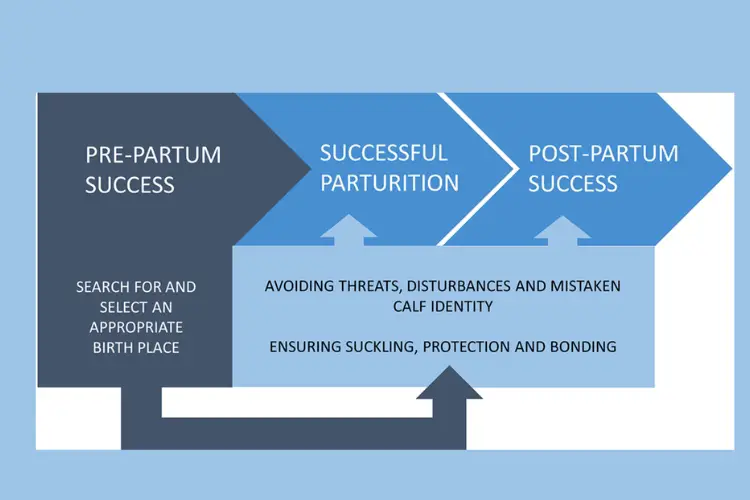
Understanding the three stages of parturition is essential for any cattle producer. Stage 1 involves the dilation of the cervix and is variable in length, potentially spanning hours or days. It’s during this stage that the cow may show signs of restlessness and isolation as her body prepares for the delivery process.
In Stage 2, the actual delivery of the calf occurs. This is when the cow’s efforts are most visible, with strong uterine contractions leading to the appearance of the calf’s feet and head. Prompt and safe delivery during this stage is crucial for the health of both the cow and the calf.
The final stage, Stage 3, is characterized by the expulsion of the placenta. Completing this stage is vital to prevent postpartum complications. Producers should monitor the cow to ensure that the placenta is expelled naturally and within a reasonable time frame to avoid retained placenta.
Each stage of parturition requires careful observation to determine if and when intervention is necessary. The following list outlines the key points to monitor:
- Observation of the cow’s behavior for early signs of labor
- Regular checks during Stage 2 to ensure progress is being made
- Post-delivery inspection to confirm the placenta has been expelled
Recognizing the Signs of Labor
Recognizing the signs of labor is crucial for timely and effective calving management. As the time approaches, several indicators can alert you to the onset of labor. Behavioral changes in the cow, such as restlessness or isolation from the herd, often precede physical signs.
Physical signs include uterine contractions, which become more frequent and intense as labor progresses. The appearance of the ‘bloody show,’ a discharge resulting from the rupture of small blood vessels in the cervix, is another key indicator. Additionally, the relaxation and dilation of the cervix are preparatory steps for the delivery process.
Below is a list of signs that may indicate labor is imminent:
- Behavioral changes (restlessness, isolation)
- Uterine contractions
- Bloody show
- Cervical relaxation and dilation
- Rupture of membranes
It’s essential to monitor these signs closely to ensure that you are prepared to assist the cow when necessary and to intervene if complications arise.
The Importance of Adequate Colostrum
Colostrum is the first form of milk produced by the mammary glands of mammals immediately following delivery of the newborn. Its role is critical as it contains antibodies essential to the calf’s early immunity.
Newborn calves have little to no immune system upon birth, making the first feeding of colostrum extremely important to the newborn calf’s survival.
Adequate colostrum intake is not just about quantity; the quality and timing are equally vital. Calves should receive colostrum within the first 2 to 4 hours post-birth for maximum absorption of antibodies.
The golden rule for colostrum feeding is the ‘4 Qs’: Quickly, Quantity, Quality, and Quietly. Here’s a simple checklist to ensure proper colostrum management:
- Ensure the first feeding occurs within 2 to 4 hours of birth.
- Provide a volume of 10% of the calf’s body weight (about 2-4 quarts for an average-sized calf).
- Assess colostrum quality using a Brix refractometer or colostrometer.
- Minimize stress by handling the calf and dam quietly and gently.
Remember, the benefits of colostrum extend beyond immediate immunity; it sets the foundation for the calf’s future health and productivity. Ensuring calves receive adequate colostrum is a necessary means to maintain appropriate welfare of the calves and is a cornerstone of successful calf-rearing practices.
Calving Supplies Checklist
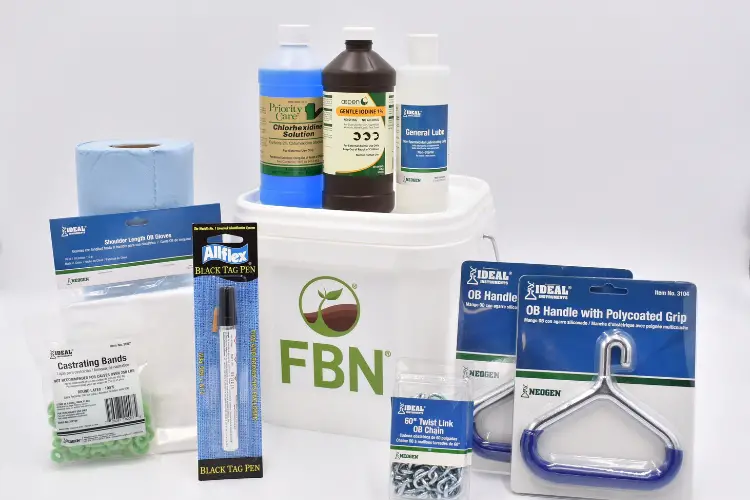
Medical and Sanitation Equipment
Ensuring the health and cleanliness of both the cow and the newborn calf is paramount during the calving process. Proper sanitation practices are not only vital for preventing disease but also for creating a safe environment for calving.
A well-stocked medical and sanitation kit should include items such as gloves, disinfectants, and a variety of tools for both delivery and post-calving care.
Personal protective equipment (PPE) is essential for anyone assisting with the calving. This includes durable gloves, protective eyewear, and clothing that can be easily sanitized. It’s also important to have separate clothing and footwear for working with livestock to prevent cross-contamination.
Below is a list of materials that should be stocked and ready to go before calving gets underway:
- Sterile gloves and lubricant for safe delivery
- Disinfectants and antiseptics for cleaning and decontamination
- Protective clothing, including overalls and boots
- Equipment for feeding colostrum and managing calf nutrition
- Thermometer to monitor the health of the cow and calf
Having a dedicated area for washing and disinfecting equipment is crucial. This includes facilities for hot washes and boot cleaning, which are part of a comprehensive biosecurity plan. Regular maintenance of this equipment ensures that it is always ready for use when needed.
Feeding and Colostrum Management Tools
Ensuring that newborn calves receive the necessary nutrients and antibodies is critical for their early development. Proper colostrum management is at the heart of this process. To facilitate this, a range of tools and equipment are essential for any calving operation.
One such tool is the Matilda from Dairy Tech, LLC, which simplifies the process of pasteurizing and warming colostrum. This innovative device allows for the use of Perfect Udder Bags, which streamline the collection, pasteurization, refrigeration, freezing, warming, and feeding of colostrum, all from a single container.
In addition to colostrum management, feeding tools such as nipple bottles, esophageal feeders, and automated milk replacers are vital. These tools ensure that calves are fed efficiently and safely, reducing the risk of aspiration and promoting optimal growth. Below is a list of essential items for your toolkit:
- Colostrum pasteurizer and warmer
- Perfect Udder Bags
- Nipple bottles and esophageal feeders
- Automated milk replacers
- Calibrated colostrum measuring devices
Each item plays a role in maintaining the appropriate welfare of the calves and supports a smooth calving season.
Environmental Adaptations for Seasonal Challenges
Adapting to seasonal challenges is crucial for the health and safety of both the cow and calf during the calving process.
Temperature fluctuations, precipitation levels, and other weather-related factors can significantly impact the calving environment. To mitigate these effects, it’s essential to have a strategy that includes both infrastructure and management practices.
For instance, during colder months, providing adequate shelter and bedding to ensure warmth and dryness is key. Conversely, in warmer seasons, ensuring proper ventilation and shade can prevent overheating and stress. Below is a list of environmental adaptations that can be made to address seasonal challenges:
- Insulation and heating solutions for barns and calving areas during winter
- Cooling systems, such as fans or misters, for heat stress relief in summer
- Portable shelters or windbreaks to protect against harsh winds and precipitation
- Moisture management systems to prevent mud and maintain cleanliness
By proactively adjusting the calving environment to the season, farmers can improve the welfare of their livestock and the success rate of calving.
Managing Calving Difficulties
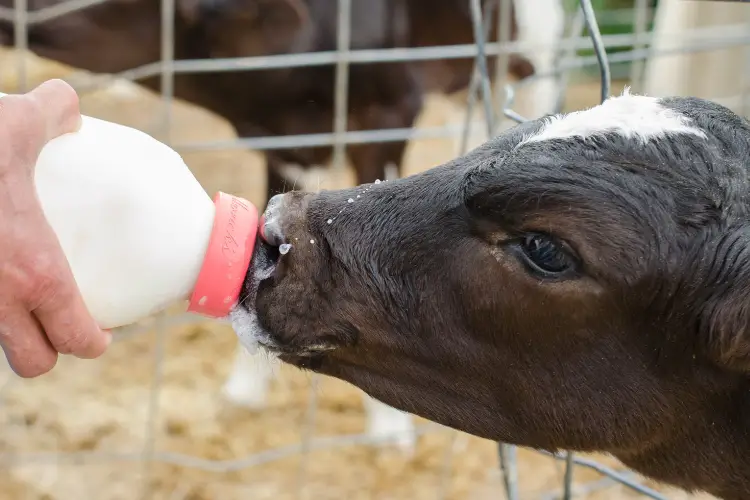
Preparing for Common Calving Complications
Calving complications can arise from a variety of factors, including poor body condition, disease, age, and anatomical issues like pelvic deformity. To mitigate these risks, it’s essential to monitor the health and condition of cows throughout pregnancy.
A proactive approach involves regular veterinary check-ups and tailored nutrition plans to ensure cows are in optimal condition for calving.
Effective preparation also includes having the right equipment and knowledge at hand. Familiarize yourself with the parturition process and be ready to assist if necessary. Below is a list of items to have in your calving kit:
- Obstetrical gloves and lubricant
- Calving chains and handles
- Clean towels and a warming box for the calf
- Colostrum or colostrum replacer
- Iodine solution for navel disinfection
Remember, timely intervention can prevent many complications, but knowing when to call for professional help is crucial. Keep your veterinarian’s contact information readily available and establish a clear plan for emergencies.
When to Call the Vet: Recognizing Emergencies
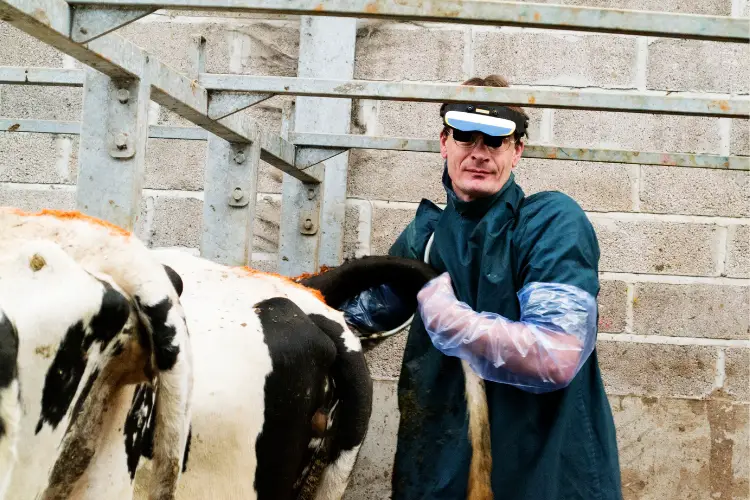
In the event of a calving emergency, early detection is crucial for the health of both the cow and calf. It’s important to monitor the calving process closely and be aware of any signs that may indicate a problem. If you encounter a situation where you’re unsure if things are progressing normally, it’s essential to seek assistance immediately.
Here are some signs that should prompt you to call your vet without delay:
- Excessive straining by the cow without progress
- The cow has been in labor for over two hours without delivering
- Abnormal or bloody discharge
- The calf is visible but not advancing
- The cow or calf shows signs of severe distress
Remember, it’s better to be proactive and consult with your vet rather than risk the health of your livestock. As Rachael Laukart emphasizes, if you’re in a moment of uncertainty, “absolutely raise your hand, call your vet, seek some assistance.” The well-being of your animals depends on your vigilance and prompt action in the face of potential emergencies.
Post-Calving Care for Cow and Calf
After the calf is born, immediate attention to both the cow and her newborn is crucial for their long-term health and productivity. Ensure the calf receives adequate colostrum within the first few hours of life, as this first milk is rich in antibodies and nutrients essential for immunity and growth.
Monitor the cow for any signs of distress or complications, such as retained placenta or abnormal discharge. It’s also important to check that the cow is recovering well and beginning to produce milk. Providing a clean, dry, and comfortable environment will help prevent infections and support recovery.
Here is a basic checklist for post-calving care:
- Observe the calf for alertness and a strong suckling reflex.
- Administer any necessary vaccinations as per your herd health plan.
- Ensure the cow has access to clean water and high-quality forage to support milk production.
- Record the calving details for farm records and future management decisions.
Timely intervention and observation can make a significant difference in the survival and well-being of both cow and calf. If any abnormalities are noticed, do not hesitate to consult your veterinarian for advice and treatment.
Nutritional Support for Calving Cows
Supplementation Programs to Enhance Profit Potential
In the pursuit of maximizing profit potential in cow-calf operations, supplementation programs play a pivotal role.
By carefully defining the objectives of supplementation, producers can tailor their nutritional strategies to meet specific goals, whether it’s improving reproductive efficiency, increasing weaning weight, or ensuring the health of calves in challenging weather conditions.
Effective supplementation hinges on the balance between input costs and the value it adds to the calf crop. For instance, during hot weather, which poses a challenge for fall calving, the right supplements can mitigate heat stress and promote healthier conditions for calves. Below is a list of key considerations when evaluating supplementation programs:
- Assess the specific needs of your herd based on environmental factors and calving season.
- Determine the cost-effectiveness of different feed and supplement options.
- Monitor the impact of supplementation on reproductive efficiency and weaning weights.
- Align supplementation practices with the expectations of calf buyers, focusing on aspects that add value to your operation.
By implementing a strategic supplementation program, producers can not only enhance the profit potential of their operations but also contribute to the overall health and welfare of their cattle.
Preventing and Managing Milk Fever
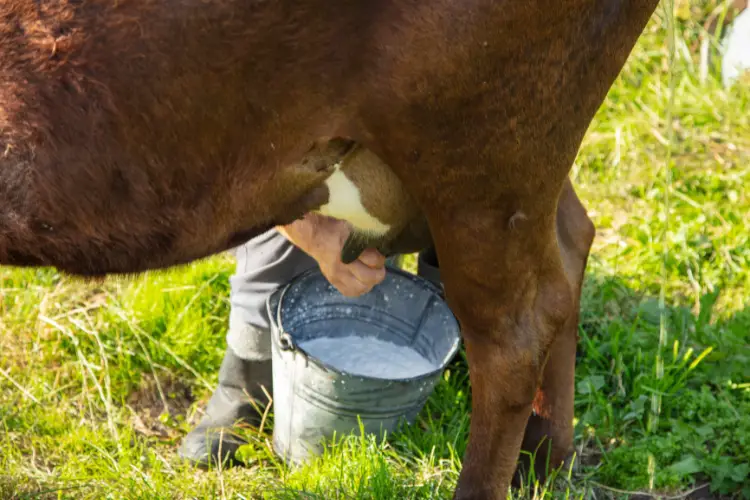
Milk fever, or hypocalcemia, is a metabolic disorder that typically affects dairy cows shortly after calving. The sudden increase in calcium demand for milk production can lead to a critical drop in blood calcium levels. Preventing milk fever is crucial as it can severely impact the health and productivity of the cow.
To manage this condition, it’s essential to monitor dietary calcium intake, especially during the transition period.
A cow’s calcium requirement jumps from about 20g per day when dry to over 80g post-calving. Adjusting the diet to include low potassium forage is recommended to help prevent milk fever. According to Teagasc, ensuring cows on the brink of calving are fed forage with less than 2.2% potassium is vital.
Here are some key steps to prevent milk fever:
- Monitor and adjust dietary calcium pre-calving
- Provide low potassium forage
- Implement a balanced mineral supplementation program
- Observe cows closely post-calving for any signs of distress
Adjusting Feed for Weather-Related Stress
As temperatures plummet, the nutritional demands of calving cows can increase significantly. For every degree of cold stress a cow faces, their energy requirements may rise by 1%. This underscores the importance of adjusting feed to meet these heightened needs, ensuring cows maintain condition and health throughout the colder months.
When considering feed adjustments, it’s essential to recognize the quality of the forage available. Poor quality hay may fill the cow but not meet her energy needs, leading to weight loss despite adequate consumption.
Conversely, high-quality forage with appropriate levels of energy, protein, and NDF (Neutral Detergent Fiber) can support optimal growth and weight maintenance.
Introducing grain or other supplements should be done cautiously to avoid digestive issues. Start with ample roughage and incrementally increase the grain portion, allowing the cow’s system to adapt. Over-conditioned animals require particularly careful management due to their metabolic sensitivity.
Remember, access to forage at all times, complemented by high-quality feed, is crucial for managing weather-related stress effectively.
Improving Calf Survival and Welfare

Effective Strategies to Prevent Calf Scours
Calf scours, a leading cause of sickness and mortality in young calves, can be mitigated through proactive management and hygiene practices. Rotating calving pastures is one such strategy that has been shown to decrease the transmission of this complex disease.
By moving pregnant cows to clean pastures, the risk of infection from pathogens in the environment is significantly reduced.
Maintaining sanitation is paramount, especially in feeding equipment and calf housing. It’s essential to always mix electrolytes according to package instructions, as incorrect concentrations can exacerbate scours. Here’s a simple checklist to ensure your calves are at a lower risk of developing scours:
- Regularly clean and disinfect calf pens and equipment
- Provide clean, dry bedding to reduce moisture and bacteria growth
- Ensure calves receive adequate colostrum immediately after birth
- Implement vaccination programs for both cows and calves
- Practice good biosecurity to prevent the introduction of new pathogens
Understanding the transmission cycles and implementing control measures are critical steps in preventing calf scours. This includes identifying and modifying management practices that could inadvertently spread disease.
Ensuring a Good Start for Baby Calves
A prosperous start for newborn calves is pivotal for their growth and overall health. Ensuring they receive colostrum within the first four hours post-calving is a key component to this early success. Colostrum is rich in antibodies and nutrients essential for the calf’s immune system development.
To maintain the appropriate welfare of the calves, several steps should be followed meticulously:
- Dry the calf immediately to prevent chilling.
- Ensure the umbilical cord is dipped in an iodine solution to prevent infection.
- Monitor the calf’s breathing and overall behavior for any signs of distress.
- Provide a clean, dry, and warm environment, especially in adverse weather conditions.
These initial actions contribute significantly to the long-term health and productivity of the calf, setting the stage for a thriving life in the herd.
Building Public Trust through Welfare Practices
In the realm of dairy farming, public trust is a cornerstone that supports the entire industry. It is built on the assurance that cows are treated humanely and that their welfare is a top priority. Animal welfare practices are not just ethical imperatives; they also have a direct impact on milk production and the overall health of the herd.
To foster this trust, it is essential to focus on the five domains of animal welfare: nutrition, environment, health, behavior requirements, and a positive mental state. These domains are supported by guidelines such as the Australian Animal Welfare Standards and Guidelines, which provide a framework for the humane treatment of livestock.
Effective communication with the community is crucial. By partnering with local councils and organizations, farmers can offer educational programs that highlight their commitment to high welfare standards. These initiatives can be both in-person and virtual, ensuring a broad reach and engagement with the public.
The importance of cow handling and a revolutionary way to practice it is a topic that resonates with consumers, emphasizing that inappropriate cow handling threatens not only the animals but also the integrity of the industry.
Conclusion
As we wrap up our guide on assembling the essential calving toolkit, it’s clear that preparation is key to a successful and stress-free calving season.
From understanding the genetic makeup of calves to managing cows in severe weather, the insights provided by experts like Teagasc advisor Tommy Cox and Mark Z. Johnson emphasize the importance of being well-equipped.
Ensuring you have all the necessary supplies on hand not only contributes to the welfare of the calves but also adds profit potential to your cow-calf operations. Remember to review your toolkit regularly, stay informed with the latest farming checklists, and be ready to adapt to challenges such as weather extremes or health issues.
With the right tools and knowledge, you can look forward to a productive calving season.
FAQs:
What are the three stages of parturition in cattle?
The three stages of parturition, or calving, in cattle are: 1) the dilation of the cervix, 2) the delivery of the calf, and 3) the expulsion of the placenta.
How can I recognize the signs of labor in cows?
Signs of labor in cows include restlessness, isolation from the herd, swelling of the vulva, mucus discharge, and the cow may repeatedly lie down and get up.
Why is colostrum important for a newborn calf?
Colostrum is crucial for a newborn calf as it provides essential nutrients and antibodies that help in building the calf’s immune system and protect against diseases.
What should I include in my calving supplies checklist?
A calving supplies checklist should include medical and sanitation equipment, colostrum management tools, and environmental adaptations like calf jackets for seasonal challenges.
When should I call the vet during calving?
You should call a vet if the cow has been in active labor for more than two hours without progress, if the calf is presented abnormally, or if the cow or calf shows signs of distress.
How can I prevent calf scours?
Preventing calf scours involves ensuring good sanitation, providing adequate colostrum immediately after birth, and managing calving pastures to reduce pathogen exposure.


